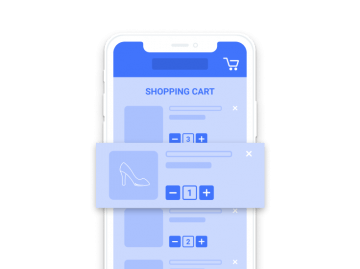Increasing mobile app retention focuses on the users returning to the application. In practice, this usually means the need to focus your activities on long-term effects. One-time advertising campaigns may result in a short-term increase in traffic in the application, but will not contribute to building a stable base of returning customers. That’s why it is a good idea to design a product and launch it on the market in a way that will not only attract the interest of customers, but also retain them. The mechanisms described below complement each other to form a whole that helps to achieve this effect.
1. Special promotions for users
One of the ways to increase retention is price promotions. An example of a limited number of available items and a limited duration of promotion is, for example, the “Hot Shot” available in x-kom’s application.

Users of x-kom’s application can see the attractive offer of the day on the home page. They also receive push notifications about it, and this way they can quickly react, gaining an advantage over desktop users.
Dedicated offers can also be built based on an analysis of earlier user behavior: if you know what products your customer was viewing, you can offer them at a better price. Moreover, an additional incentive to use the mobile app is to limit the distribution of some of the offers to the mobile channel.
Price promotions can be supplemented with cross- and up-selling (e.g. “Buy two products from a given category and get the third one for free”) and the shopping volume can be increased in this way.
2. Smart push notifications
Behavioral and geolocalization data, often acquired in real time, make it possible to precisely reach people in the right time and place (e.g. “Hi! Low on energy? We’re right next door – [here’s the address of the nearest café] drop by for a morning espresso! Today with a discount [here’s the value of the promotion]”). This gives them with an advantage over, for example, remarketing based on cookies. By giving the right value to the user through a personalized message, you can increase the likelihood of a purchase.
Of course, sending a large number of notifications in a reckless way is pointless – it can discourage users and make them stop using the application or even uninstall it. It is therefore good practice to allow users to manage notification preferences.
A well-designed push notification should be short, legible, and most important: unambiguously communicate to the user the benefit of returning to the application. An opportunity to stimulate the user’s interest is also the use of rich push notifications, which instead of text can have an icon and image in their content.
3. App Indexing, i.e. indexing applications in the search engine
In 2015, after three years of testing, Google finally decided to introduce the function of indexing applications in the search engine for general use (selected developers gained access to it two years earlier, and their applications have blazed the trail for successors). Currently, Google indexes applications for iOS and Android mobile devices, which means, above all, much greater opportunities to reach recipients. By indexing applications, potential users can find them in Google search results. Naturally, we are talking about people browsing the web from the level of phones and tablets. If they have the given application, clicking on the link will automatically take them to one of its screens (e.g. an answer to a specific question on the Quora). If not – they can install the application by clicking a button on the results page (or on the mobile version of your site). Then, they are transferred directly to the App Store or Google Play platform.

It should be mentioned that Google only indexes applications that meet the conditions. The programming documentation for the app indexing is available at Firebase App Indexing. Implementation of functions that enable indexing (e.g. deep links from the mobile site to the application’s screens) should take place at the stage of work on the program and be a part of a wider plan of presence on the Internet. The implementation process of the app indexing itself varies depending on the operating system (it is different in the case of iOS or Android) and has been described in detail here (iOS) and here (Android).
The most important benefit of implementing app indexing is the ability to send users directly from search results to specific application screens, which can significantly increase the number of conversions (but at the expense of visits to the website).
We have written about the ways to increase conversions in the shopping cart in an m-commerce application in the article: 9 tips how to design a mobile checkout process.
4. Links opening the application placed in mailings, social media, etc., (so-called deep linking)
Deep linking, i.e. links that open the application and take users using mobile devices directly to a specific screen, can be used, for example, in mailings or ads in social networks. Deep links are particularly well suited for mailings and Facebook Ads.
In addition, deep linking may contain rules that check, for example, whether the user has the current version of the application, transferring the user to the market in order to encourage an update.
5. Google UAC – Universal campaigns promoting applications with the set goal of the event
Universal App Campaigns (UAC) are a good option for people who want to automate the processes of advertising; after uploading all the necessary materials to AdWords, the ad distribution system will decide what and how to display to whom and when, in order to achieve the set goal.
In the case of such campaigns, Firebase platform solutions should be first implemented in your mobile application, allowing you to set previously defined events in the application.
You can read more about Universal App Campaigns on the official Google help page. There, we will also find information on various ways of configuring targets focused on retention.
6. Increase of mobile app retention beyond digital marketing: ATL and BTL
The promotion of a mobile app does not have to be limited to internet marketing. ATL (above the line) promotion, e.g. billboards, press, leaflets, as well as BTL (below the line) promotion, e.g. urban games in augmented reality environment, POSs, properly applied, can work equally well.
Summary
Remember that applications are aimed at building a long-term relationship with returning users. Therefore, work on retention and ways to increase it should start at the design stage of the application. If paid promotion turns out to be the only source of retention in practice, it is definitely worth looking for the reasons for the low return of users in the application itself and implement the appropriate changes.
If you’re interested in the subject of mobile loyalty 2.0., related to the issue of retention, check out our previous article: How to build customer loyalty through mobile apps.
You might also like

Increasing mobile app retention focuses on the users returning…

Most marketing and e-commerce experts agree that m-commerce applications…

The number of people shopping through mobile devices is…

There has been much talk of e-commerce in recent…

App Store Optimization, or ASO, entails the process of…



